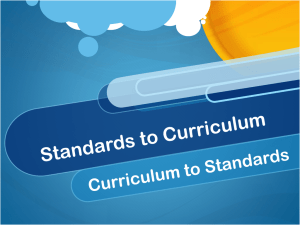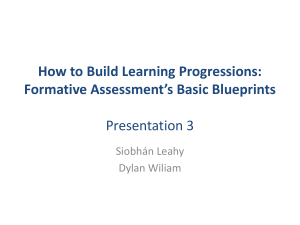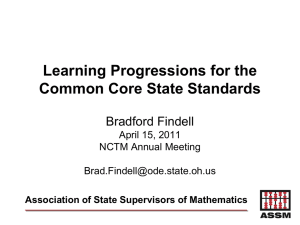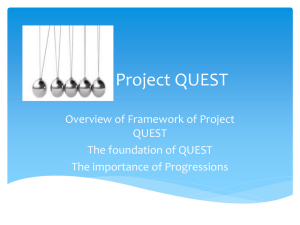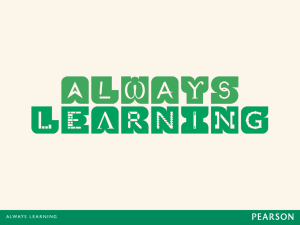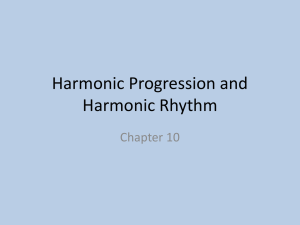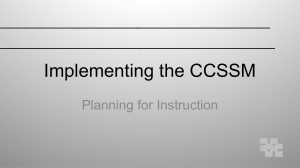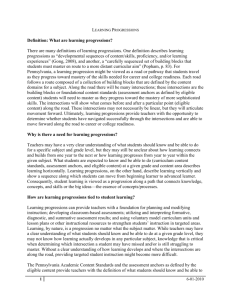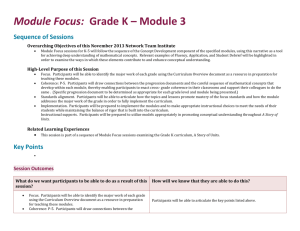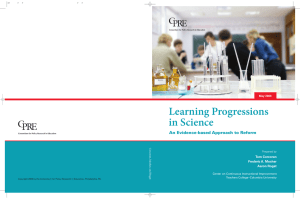Hess_D3a_2_PP learning progressions intro_2014
advertisement
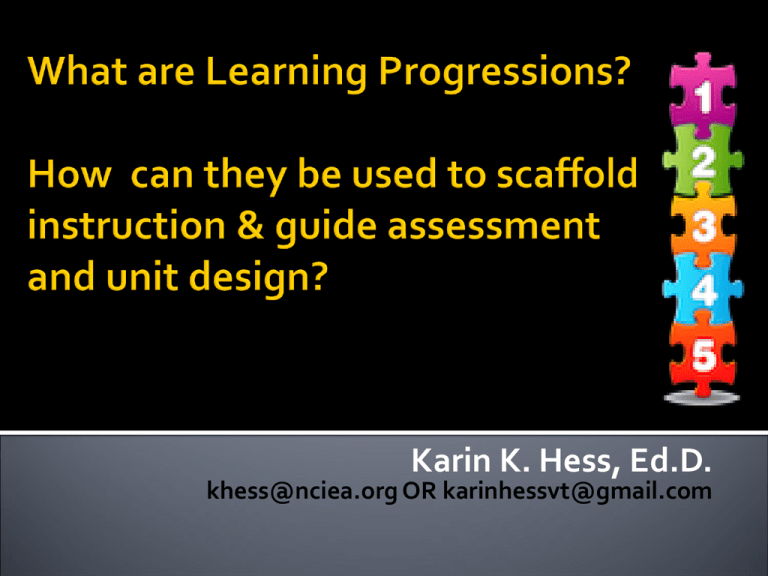
Karin K. Hess, Ed.D. khess@nciea.org OR karinhessvt@gmail.com Anticipation Guide Defining learning progressions Four Guiding Principles of LPs (Hess article, 2008) Standards vs. Learning Progressions Aligning Instruction & Assessment with LPs Instructional building blocks Pre-assessments/planning lessons Building expertise Student Work Analysis 1. Learning progressions are the same as a scope and sequence or pacing guide that lists the order of what to teach next. 2. Big ideas help to frame descriptors (progress indicators) in a learning progression. 3. An example of a big idea would be: learning how to read. 4. To validate a learning progression, one would consult cognitive research, as well as teacher observations and analysis of student work collected over time after targeted instruction. 5. Students can use learning progressions as a selfassessment to monitor their own progress. 6. Learning progressions can be used to diagnose individual students’ strengths and weaknesses. 7. Progress maps, developmental continuums, and learning continuums are qualitatively different from learning progressions. 8. Other countries have been using research-based learning progressions for many years to guide classroom assessment and instruction. 9. Learning progressions can guide development of formative assessments and formative uses of assessment data. 10. Learning progressions describe increasingly more difficult content and skills. Hawai’i Progress Maps Project 2 years to develop LPs with teachers (using available research and professional judgment) 1 year to implement and track “struggling learners” (pre-mid-post assessments) 50 teachers - K-8 ELA and math Progression descriptions validated & revised using student work samples analyzed collaboratively What do you notice? What do you wonder about? “descriptions of the successively more sophisticated ways of thinking about an idea that follow one another as students learn” (Wilson & Bertenthal, 2005) “a picture of the path students typically follow as they learn...a description of skills, understandings, and knowledge in the sequence in which they typically develop” (Masters & Forster,1996) Learning progressions propose the intermediate understandings that are “reasonably coherent networks of ideas and practices…that contribute to building a more mature understanding…the important precursor ideas may not look like the later ideas, yet crucially contribute to their construction.” (Duschl, et al., 2007) Planning & Modifying Curriculum and Instruction Developing Meaningful Assessments – especially formative assessments Monitoring Progress Mastery of Specific Benchmark Concepts & Skills over time Novice Expert Performance: increased sophistication & deeper understanding 1. Based on (& refined by) available Research 2. The big ideas/the “essence” of concepts/processes are the binding threads that connect steps on the pathway 3. May not be linear, but articulate movement toward increased understanding (e.g., deeper, broader; ability to apply, generalize, or transfer; more sophisticated) – not just harder! 4. Go hand-in-hand with well-designed/aligned assessments Standards identify endpoints – grade level targets for learning. These can only be thought of as “curricular progressions” across grades (not based in research about student learning over time) Standards are not prescriptive – they do not indicate or suggest an “optimal” instructional sequencing plan (especially within grade levels) Standards do not provide guidance about how different standards might be linked for instruction ------ or how to build expertise (transfer) when learning Targets (defined by key core ideas of each discipline): Understanding of core ideas and practices at the level thought to support postsecondary success. Starting Points: Children’s initial, or early, ideas and ways of thinking that they bring to school. In between: An hypothesized ordered progression of the levels through which understandings and skills shift and develop as the student progresses toward the desired target. Vygotsky: Zone of Proximal Development (What a child can do with assistance today) What a child can do independently now: “ENTRY” Actual Development Area The ZONE What a child can do independently tomorrow/future Potential Development Area LEARNING PROGRESSIONS ZONE: Dynamic area Causes development to move forward Social interaction essential (scaffolding) Learning Progressions “Link” the Zones of Proximal Development of ALL Students Novice Performers --------------------------------------------------Expert Explore & challenge preconceptions Guide & scaffold practice Find each student’s starting point for learning Extend, initiate, demonstrate sophistication Proficient & independent Create schemas; deepen & broaden conceptual understanding Sub-skills that develop conceptual understanding Prerequisite knowledge or emergent skills Transfer to new contexts Many (but not all) students are here. Hess, 2008 Distinguishing differences is foundational to scientific observation, the ability to make predictions, and sequencing & interpreting observations, as well as learning to read, comparing and ordering numbers in math) Distinguishes differences in physical characteristics Identifies similarities in physical characteristics Identifies both differences and similarities in physical characteristics Categorizes objects and materials by physical characteristics (external, then internal features) Explains why things belong to a specific group; creates groupings Distinguishes relevant differences from non-relevant differences when trying to answer a specific question Categorize objects and materials by function and by multiple features or broader categories or classification systems Excerpt from the Grade 7 ELA Learning Progressions Framework: Progress Indicators (shaded) /”Steps” for Reading Informational Texts, with related gr 7 Common Core standards, and possible instructional Building Blocks for each step (PI) in the learning progression M.RI.j use supporting evidence to summarize central ideas, draw inferences, or analyze connections within or across texts (e.g., events, people, ideas) 7.RI-1, 2, 3, 9 M.RI.i utilize knowledge of text structures and genre features to locate, organize, or analyze important information 7.RI-5 M.RI.h flexibly use strategies to derive meaning from a variety of print/nonprint texts 7.RI-4; 7.L-4, 5a; 7.SL-2 Instructional Building Blocks for this PI might begin with Listen for key ideas and details in news/media stories 7.SL-2 Interpret visuals in informational texts (e.g., arrows in a graphic organizer showing how a plant grows or how water evaporates) 7.SL-2 Answer the question: does this word make sense? 7.RI-4; 7.L-4 Instructional Building Blocks for this PI might include: Locate text evidence /key details to support inferences about central ideas in a text 7.RI-1 Instructional Building Blocks for this PI Summarize central ideas 7.RI-2 might include: Find similar OR different information Locate & use informational text about a topic in two or more texts 7.RI-9 features to answer questions (captions, Draw inferences from or explain titles, headings, etc.) connections among ideas, events, or Identify the kind of information found in individuals discussed in a text 7.RI-3 different informational texts (e.g., newspaper versus magazine) Recognize structures that help to organize information (e.g., introduction, body, conclusion; signal words for compare-contrast, proposition-support, etc.) 7.RI-5 O I C COGNITION: Presents a model of how students represent knowledge and develop competence in a subject domain; OBSERVATION: Guides development of tasks/situations that allow one to observe student performance; and INTERPRETATION: Offers an interpretation method of drawing inferences from the performance evidence. [Knowing what Students Know, 2001] 1. Identify unit focus/ end point & “big idea” 2. Review key words in each LP Progress Indicator for the grade level or grade span M.WP.a using strategies to better understand genre of persuasive writing (e.g., discuss opposing perspectives; analyze mentor texts – ads, essays, book/movie reviews, speeches, propaganda techniques) 3. Check related CC standards for that grade what (parts) will you focus instruction on across the unit of study? 4. Draft a possible summative assessment for the unit – what will they be able to do at the end of the unit? 5. Develop lesson 1 as pre-assessment, based on pre-requisites for success to build upon 6. Use PIs to determine instructional building blocks & plan a general lesson sequence and formative assessments to monitor progress 7. Use student work analysis at several points (pre/mid/post) to inform instruction Student Work Analysis (SWA): a “quick sorting” of papers Objectives not met Objectives Objectives partially met met Exceeds Objectives ___% of class ___% of class List Students + Describe what they typically did ___% of class ___% of class Determine what each group of students needs next… Not linear Many “strands” in each content discipline Break down standards and/or combine standards based on HOW people learn and develop expertise over time Still require targeted instruction Some ‘steps’ in progressions are not represented in grade-level standards, but they are important to developing expertise Others ? Numerous papers & presentations available at www.nciea.org (Hess, 2008) Developing and using learning progressions as a schema for measuring progress. (Hess, 2010; 2011) Learning Progressions Frameworks for ELA and Mathematics with alignment to Common Core State Standards (Hess, 2012) Literacy profiles by grade span (K-2, 3-4, 5-6, 78, 9-12) You can request -- Hess’ “Local Assessment Toolkit” Student Work Analysis tool LPF planning tools for unit design Hess (2010) Science & Children article Hawaii video – soon to be posted at www.karin-hess.com
